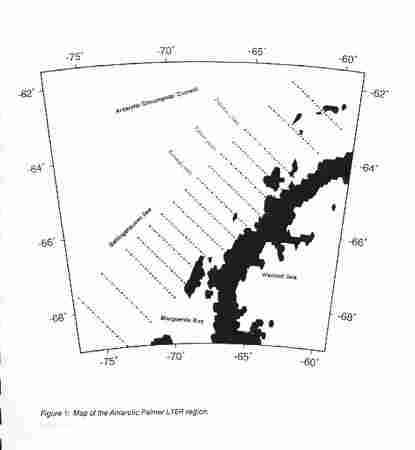5 February, 1998
Gould-en Greetings:
Wouldn't you know it, just as the ship moved further south and the weather
turned colder, now is the time I'm going to have to work outside!!! You
would think I could plan things better! My project involves collecting
water samples and doing one of the following with each sample: putting some
in raw sea water baths outside in the sun so I can trace the production of
oxygen; putting some in foil and incubating them in a ice chest also bathed
in raw sea water; and fixing others immediately to measure the oxygen level
when the samples were collected. The last bottle involves putting a poison
in the water to kill any organisms (microscopic algae -- no critters) and
incubating that in the sun and sea water. What would be the purpose of the
last bottle? Why do you think that all the bottles are put in raw sea water?
The gentleman I am working with on my project is Chris Carillo who is
working on his doctorate under Dave Karl. Chris got his MS in Biological
Oceanography from University of California San Diego. He is studying the
dynamics of the exchanges oxygen and carbon in and out of the ocean an the
implications that the exchanges have for biological production and
consumption. As Chris explained to me, the ocean "breathes." In spring and
summer it gives off oxygen. In the fall and winter, it takes it back in.
The opposite is true for carbon. One of the questions he is trying to find
out in these studies is how the carbon is replaced in the cycle. Does it
come from open air exchange or does it come from deeper upwelling water?
Carbon dioxide and oxygen molecules are very different molecules. Oxygen
is less soluble. If an algae bloom were to suddenly stop, the oxygen would
come out of the water faster (carbon dioxide is buffered and leaves the
water slower). That would cause the balance of the two gases to be off.
This , in turn. would bring up other questions of what the impact on the
phytoplankton and their processes would be should this or other imbalances
occur. It is a difficult problem, but one that Chris is tackling with a
great deal of energy and persistence. (In other words, he wears me out
trying to keep up with doing all the dissolved oxygen testing!! Just
kidding.)
We are going to be taking samples on the 200 study line of the LTER site
here. As the other study lines run into land, the Marguerite Bay makes this
200 line the longest line upon which we can take data. I will be very busy
taking samples for my project these next few days as we work this line.
We have not found much in the way of algae so far, but we hope to in
Marguerite Bay as it has been an area of high productivity in the past. I
am sending a picture of the LTER sampling lines to help pinpoint where we
are.
Questions yesterday were:
*How would having the bioptics state that the readings indicate very clear
water likely affect the oxygen production? If water is clear, then more
light can get to algae; however if it is too clear, it indicates that there
is no algae in the water, therefore no oxygen production.
*What are the needs of phytoplankton to have high productivity of oxygen?
They must have all the bionutrients necessary to produce food and oxygen
and they must have light.
*What does high productivity indicate what is happening with the
phytoplankton in regard to nutrients?
High productivity would indicate that all the nutrients are in the water in
the correct abundance and ratio needed to produce food.
Any questions?
Warm regards,
Mrs. D

Contact the TEA in the field at
.
If you cannot connect through your browser, copy the
TEA's e-mail address in the "To:" line of
your favorite e-mail package.
|
